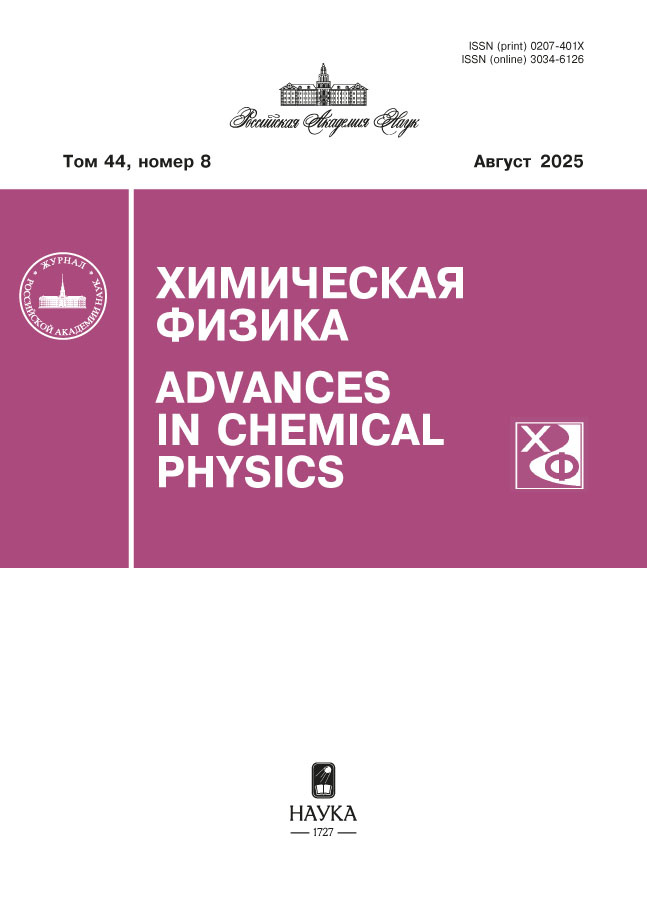Numerical simulation of laminar stoichiometric hydrogen–air flame structure
- 作者: Tereza A.M.1, Agafonov G.L.1, Anderzhanov E.K.1, Betev A.S.1, Khomik S.V.1, Cherepanova T.T.1, Cherepanov A.A.1, Medvedev S.P.1
-
隶属关系:
- Semenov Federal Research Center for Chemical Physics, Russian Academy of Sciences
- 期: 卷 44, 编号 8 (2025)
- 页面: 54-63
- 栏目: Combustion, explosion and shock waves
- URL: https://ter-arkhiv.ru/0207-401X/article/view/689002
- DOI: https://doi.org/10.31857/S0207401X25080068
- ID: 689002
如何引用文章
详细
Numerical simulations of flame structure and laminar burning velocity are performed for a stoichiometric hydrogen–air mixture under standard initial conditions. A comparative analysis is presented of the results obtained using three detailed kinetic mechanisms (DKMs), which differ both in the set of elementary reaction steps and reacting species and in the values of rate constants. It is found that the decrease in H2 concentration has a weakly pronounced two-stage character. In the presence of an additional initiation channel H2+O2=OH+OH, a pronounced second maximum of the intermediate H2O2 concentration appears. In the absence of this channel, a two-stage increase in OH concentration is observed. Based on an analysis of the sensitivity of heat release to reaction rate constants, the complex behavior of the OH and H2O2 profiles is explained. Despite the differences revealed, all three DKMs predict similar values of burning velocity and heat release rate.
全文:
作者简介
A. Tereza
Semenov Federal Research Center for Chemical Physics, Russian Academy of Sciences
编辑信件的主要联系方式.
Email: tereza@chph.ras.ru
俄罗斯联邦, Moscow
G. Agafonov
Semenov Federal Research Center for Chemical Physics, Russian Academy of Sciences
Email: tereza@chph.ras.ru
俄罗斯联邦, Moscow
E. Anderzhanov
Semenov Federal Research Center for Chemical Physics, Russian Academy of Sciences
Email: tereza@chph.ras.ru
俄罗斯联邦, Moscow
A. Betev
Semenov Federal Research Center for Chemical Physics, Russian Academy of Sciences
Email: tereza@chph.ras.ru
俄罗斯联邦, Moscow
S. Khomik
Semenov Federal Research Center for Chemical Physics, Russian Academy of Sciences
Email: tereza@chph.ras.ru
俄罗斯联邦, Moscow
T. Cherepanova
Semenov Federal Research Center for Chemical Physics, Russian Academy of Sciences
Email: tereza@chph.ras.ru
俄罗斯联邦, Moscow
A. Cherepanov
Semenov Federal Research Center for Chemical Physics, Russian Academy of Sciences
Email: tereza@chph.ras.ru
俄罗斯联邦, Moscow
S. Medvedev
Semenov Federal Research Center for Chemical Physics, Russian Academy of Sciences
Email: tereza@chph.ras.ru
俄罗斯联邦, Moscow
参考
- A.L. Sanchez, and F.A. Williams, Prog. Energy Combust. Sci. 41, 1 (2014). https://doi.org/10.1016/j.pecs.2013.10.002
- V.V. Gubernov. PhD. Theses. Moscow: Lebedev Phys. Inst., RAS, 2013.
- A.G. Shmakov. PhD. Theses. Novosibirsk: IKhKG SO RAS, 2022.
- S. Kudriakov, E. Studer, C. Bin, Int. J. Hydrogen Energy 36 (3), 2555 (2011). https://doi.org/10.1016/j.ijhydene.2010.03.138
- G. Gai, S. Kudriakov, B. Rogg et al., Int. J. Hydrogen Energy, 44 (31), 17015 (2019). https://doi.org/10.1016/j.ijhydene.2019.04.225
- I.S. Yakovenko, M.F. Ivanov, A.D. Kiverin, K.S. Melnikova, Int. J. Hydrogen Energy 43, 1894 (2018). https://doi.org/10.1016/j.ijhydene.2017.11.138
- I.S. Yakovenko, A.D. Kiverin, K.S. Melnikova, Fluids 6, 21 (2021). https://doi.org/10.3390/fluids6010021
- S. Yakovenko, I.S. Medvedkov, A.D. Kiverin, Russ. J. Phys. Chem. B 16, 294 (2022). https://doi.org/10.1134/S1990793122020142
- A.M. Tereza, G.L. Agafonov, E.K. Anderzhanov, et al., Russ. J. Phys. Chem. B 17 (4), 974 (2023). http://dx.doi.org/10.1134/S1990793123040309
- A.M. Tereza, G.L. Agafonov, E. K. Anderzhanov et al., Russ. J. Phys. Chem. B 17 (6), 1294 (2023). http://dx.doi.org/10.1134/S1990793123060246
- Moroshkina, E. Yakupov, V. Mislavskii et al., Acta Astronautica 215, 496 (2024). https://doi.org/10.1016/j.actaastro.2023.12.032
- D.A. Frank-Kamenetskii, Diffusion and Heat Transfer in Chemical Kinetics (Plenum, New York, 1969).
- Z. Hong, D.F. Davidson, R.K. Hanson, Combust. and Flame 158 (4), 633 (2011). https://doi.org/10.1016/j.combustflame.2010.10.002
- Keromnes, W.K. Metcalfe, K.A. Heufer, et al., Combust. and Flame 160, 995 (2013). https://doi.org/10.1016/j.combustflame.2013.01.001
- G.P. Smith, Y. Tao, H. Wang, Foundational Fuel Chemistry Model Version 1.0 (FFCM-1). 2016. http://web.stanford.edu/group/haiwanglab/FFCM-1/index.html
- H. Hashemi, J.M. Christensen, S. Gersen, P. Glarborg, Proc. Combust. Inst. 3, 553 (2015). https://doi.org/10.1016/j.proci.2014.05.101
- A.A. Konnov, Combust. and Flame 203, 14 (2019). https://doi.org/10.1016/j.combustflame.2019.01.032
- Y. Zhang, J. Fu, M. Xie, J. Liu, Int. J. Hydrogen Energy 46 (7), 5799 (2021). https://doi.org/10.1016/j.ijhydene.2020.11.083
- P. Krivosheyev, Y. Kisel, A. Skilandz et al., Int. J. Hydrogen Energy 66, 81 (2024). https://doi.org/10.1016/j.ijhydene.2024.03.363
- V.F. Nikitin, E.V. Mikhalchenko, L.I. Stamov et al., Acta Astronaut. 213, 156 (2023). https://doi.org/10.1016/j.actaastro.2023.08.036
- N.N. Smirnov, V.V. Azatyan, V.F. Nikitin et al., Int. J. Hydrogen Energy 49 (B2), 1315 (2023). https://doi.org/10.1016/j.ijhydene.2023.11.085.
- N.N. Smirnov, V.F. Nikitin, E.V. Mikhalchenko et al., Int. J. Hydrogen Energy 49 (B2), 495 (2023). https://doi.org/10.1016/j.ijhydene.2023.08.184
- A.M. Tereza, G.L. Agafonov, E.K. Anderzhanov et al., Russ. J. Phys. Chem. B 17 (6), 1294 (2023)..
- CHEMKIN-Pro 15112. Reaction Design, San Diego, CK-TUT-10112-1112-UG-1., 20
- Alekseev V. PhD. Theses. Lund, Sweden: Lunds Univ., 2015.
- A.E. Lutz, R.J. Kee, J.A. Miller, Sandia National Laboratories, Livermore, CA SAND 87-8248 (1998).
- A.M. Tereza, G.L. Agafonov, E.K. Anderzhanov et al., Russ. J. Phys. Chem. B, 18 (4), 965 (2024). https://doi.org/10.1134/S1990793124700416
- R.J. Kee, J.F. Grcar, M.D. Smooke, J.A. Miller, Sandia National Laboratories, Livermore, CA, SAND85-8240 (1985).
- O.C. Kwon, G.M Faeth, Combust. and Flame 124, 590 (2001). https://doi.org/10.1016/S0010-2180(00)00229-7
- V.A. Bunev, V.N. Panfilov, and V.S. Babkin, Combust. Explos. Shock Waves 43 (2), 125 (2007). https://doi.org/10.1007/s10573-007-0017-2
- O.P. Korobeinichev, V.M. Shvartsberg, S.B. Il’in et al., Combust. Explos. Shock Waves 35 (3), 239 (1999). https://doi.org/10.1007/BF02674444
- V.V. Azatyan, Kinet. Catal. 61 (3), 319 (2020). https://doi.org/10.1134/S0023158420030039
- S. Medvedev, G. Agafonov, S. Khomik, Acta Astronautica 126, 150 (2016). https://doi.org/10.1016/j.actaastro.2016.04.019
补充文件













